Contents
It can be difficult for a spinner with little experience to choose a jig load from the variety of options presented on the shelves of fishing stores. When selecting this element of equipment, it is necessary to take into account not only its weight, color and type of material from which it is made, but also the design features of specific models.
Materials used for manufacturing
For the manufacture of jig types of cargo, several types of materials are used:
- lead;
- tungsten;
- hard plastic.
Each of these materials has its own advantages and disadvantages, which must be taken into account when buying or making your own jig sinkers.
Lead
The vast majority of spinners use lead jig heads. Cargo from this material has a number of advantages:
- low cost;
- large specific gravity;
- the possibility of self-production.
Lead is an inexpensive and easy-to-work metal, so the price of cargo made from this material is low. This is a very important factor, since when fishing in the snarled sections of the reservoir, more than a dozen jig heads can be torn off in one fishing trip.
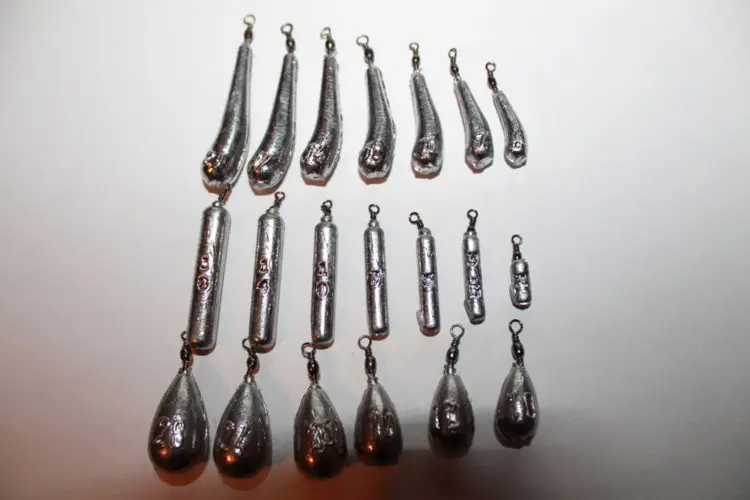
Photo: www.salskfisher.ru
Lead has a high specific gravity. This makes the lure more compact and improves its aerodynamic performance, which is conducive to long-distance casts.
Since lead is a fusible and soft metal, it is fairly easy to make lead weights at home. Do-it-yourself production reduces fishing costs and allows you to create jig heads that are optimally suited to the conditions of fishing in a particular reservoir.
The main disadvantage of lead is excessive softness. This quality negatively affects the result of fishing when angling such fish as zander. After attacking the bait, this predator clenches its jaws strongly, and its fangs get stuck in the plastic load, which makes it impossible to make a high-quality strike.
Wolfram
Tungsten is one of the rather expensive and hard-to-cut metals; therefore, cargoes made from this material are several times more expensive than lead products. Frequent breaks of such jig heads, leading to their repeated purchases, can significantly hit the spinner’s budget.
Since tungsten is a refractory and difficult to process metal, it will be quite problematic to make a load from this material on your own. The acquisition of such products also causes certain difficulties, since they are not sold in all fishing stores.
The advantages of tungsten jig heads include:
- hardness;
- large specific gravity;
- resistance to oxidation.
Since the tungsten load has increased hardness, the predator’s teeth do not get stuck in it after the attack. This allows you to perform high-quality hooking, which has a positive effect on the results of fishing.
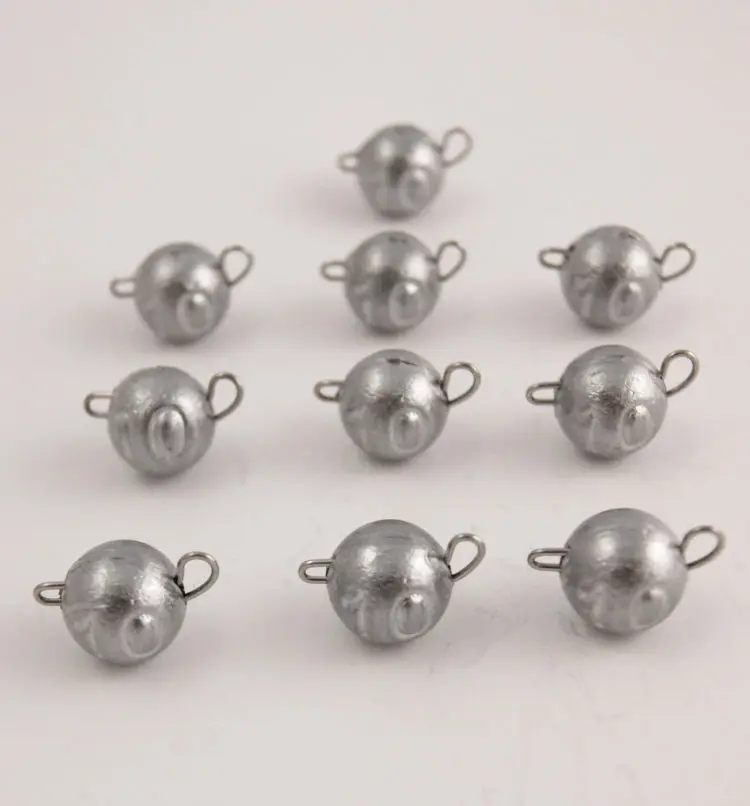
Pike perch, bersh and perch usually stick to areas of the reservoir where solid ground prevails. When performing stepped wiring, hitting stones and shells, the tungsten “head” makes a sound that is clearly audible under water, which helps to attract a predator.
Due to the large specific gravity of tungsten, weights made from this material, with a small size, have a fairly significant mass. This quality is especially important when it comes to nano jig fishing, where the visual volume of the bait often plays a decisive role.
With prolonged use, lead jig heads oxidize and begin to look very unpresentable. This does not happen with tungsten products.
Plastic
Plastic jig weights are rarely used by spinningists, however, under certain conditions, they can be very effective. Such “heads” have positive buoyancy and have proven themselves in situations where the predator feeds in the middle layers of the water.
Plastic models are used in combination with lead rigs. When retrieving, the main load goes near the bottom, and the bait, mounted on a floating “head”, moves in the middle layers of the water.
Choice of cargo weight
The weight parameter of the jig load is very important. It affects not only the casting distance of the bait, but also its behavior during wiring.
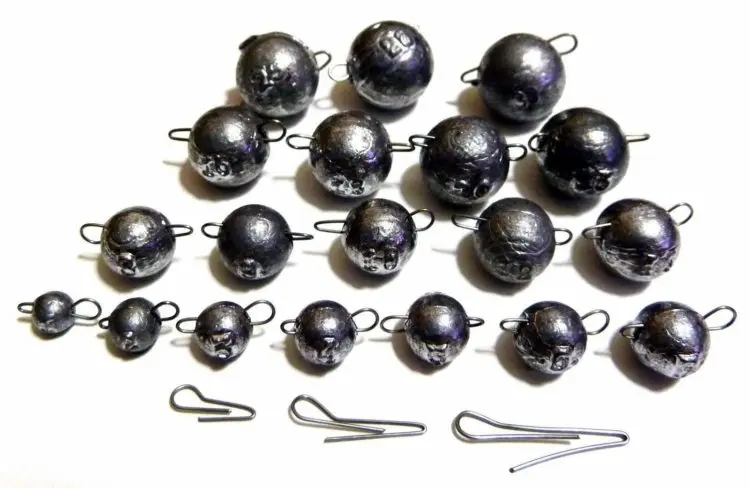
When choosing the weight of a jig head, you need to focus on the following indicators:
- class of tackle used;
- approximate depth at the place of fishing;
- flow rate or lack thereof;
- required casting distance;
- required bait delivery style.
When fishing with nanojig gear, very light sinkers weighing no more than 3 g are used. Such “heads” are used in areas with no current and up to 3 m deep, and the casting distance is limited to a distance of 20 m.
If fishing is carried out with ultralight class tackle, loads weighing up to 3-7 g are used. They work well at a depth of up to 6 m. They can be used both in still water and in weak currents. The maximum casting distance of such jig heads is 35 m.
Angling with a light class spinning rod involves the use of “heads” weighing 7–20 g, which can be used in standing and running water at a depth of up to 8 m. Such sinkers are designed for fishing at a distance of up to 50 m.
For medium-class tackle, jig heads weighing 20–50 g are optimally suited, which can be used on any type of reservoir and a depth of more than 3 m. With their help, it is possible to cast the bait at a distance of up to 80 m.
When fishing with a heavy class jig, loads weighing 60–100 g are used. It is advisable to use such models when fishing in strong currents and great depths. If the tackle is chosen correctly, they can be thrown over a distance of more than 100 m.
By varying the weight of the head, you can change the style of feeding the bait. The smaller the mass of the sinker, the slower the twister or vibrotail will sink during pauses during the wiring.
jig head color selection
When catching predatory fish, the color of the jig head is not critical. If fishing is carried out in clear water, unpainted options can be used. When fishing takes place in muddy water conditions, it is better to use bright models that contrast with the color of the bait.
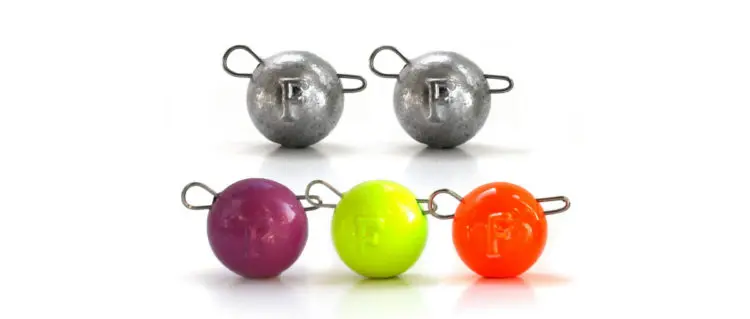
When it comes to catching peaceful fish with a nano jig, the color of the “head” can be very significant. In this case, the color of the cargo is selected empirically in the process of fishing. That is why the spinning player needs to have options of different colors in his arsenal.
Pros and cons of different models
There are many modifications of jig heads that differ in shape and design features. Having learned to select the type of load that best suits the conditions of fishing, the spinner will be able to successfully fish on any type of reservoir.
“Ball”
A ball-type fishing load is a metal element of a spherical shape with a hook and a fixing ring soldered into it. It is often used in combination with various silicone baits.
In order for the “silicone” to hold better and not fly off during a cast or attack by a fish, there is a part in the place where the hook is soldered with a metal element in the form:
- simple thickening;
- a small “fungus” or notch;
- wire spiral.
Models where a simple thickening acts as a holding element are now rarely used. This is due to the fact that the silicone bait is fixed extremely unreliably on them and flies off quite quickly.
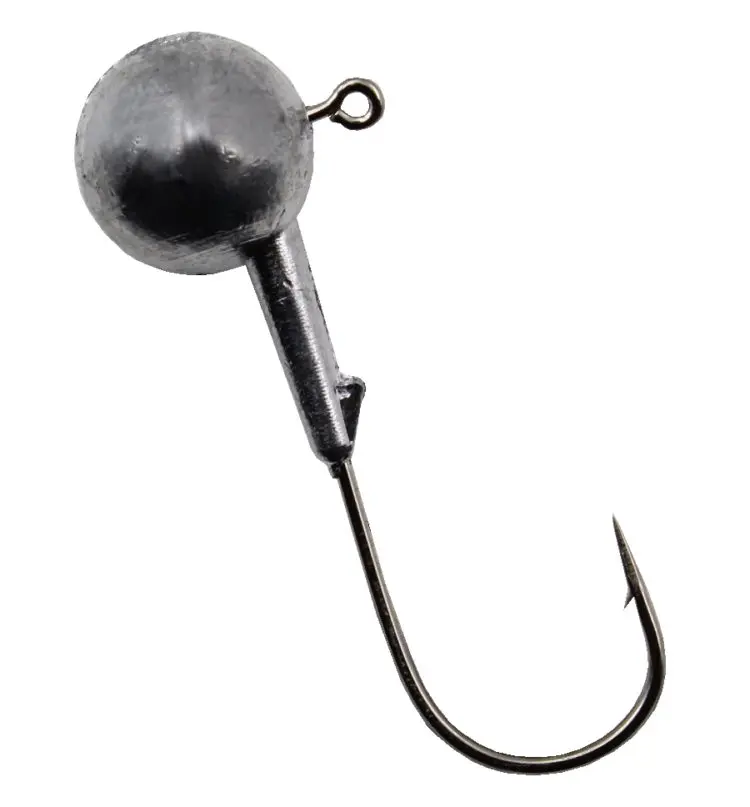
The “ball”, in which the fixing part is a notch or a drink in the form of a small “fungus”, is used by spinningists much more often. On these types of sinkers, the “silicone” holds much better, which allows for repeated replanting of the bait.
Best of all, “silicone” is held on “heads” equipped with a wire spiral wrapped around the shank of the hook. Such models are well suited for fishing on “edible” rubber, which is characterized by increased softness.
The ball-type sinker has several significant drawbacks:
- does not have good aerodynamics, which negatively affects the casting distance;
- due to the “deaf” soldering of the hook with the sinker, the bait mounted on the “ball” has minimal activity during wiring;
- often clings when angling in the snarled sections of the reservoir.
When playing, the fish can use the soldered structure as a shoulder to release the hook, which is also a serious drawback of this model.
“Ball” can be made in a non-engaging version (for fishing in snarled areas). To do this, 1-2 thin, elastic pieces of wire are fixed on the shank of the hook, protecting the sting from hooks. However, using such structures, you need to understand that the number of effective hooks will also be reduced.
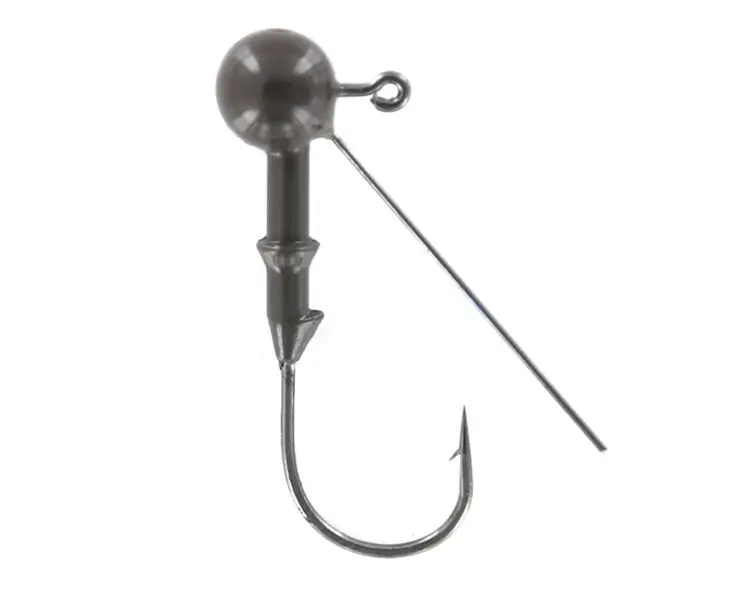
There are also sinkers of the “ball” type with an offset hook. They usually weigh no more than 10 g and are designed for fishing in tight shallow water.
“Cheburashka”
When fishing a predator using the classic jig method in the bottom layers, most spinningists use a sinker like “cheburashka”. It may have a spherical shape or be slightly flattened laterally.
On both sides of the “cheburashka” there are 2 wire ears, to one of which the main fishing line is attached through a carabiner, and to the other – the bait (through the winding ring). This design has several advantages:
- can be equipped with any type of hooks, which makes it possible to fish both in clean places and in snags;
- has good aerodynamics, which allows you to perform ultra-long casts;
- thanks to the articulated connection of the elements, an active game of the bait is ensured.
The price of “cheburashka” in stores is much lower than the cost of other models – this is important, since about a dozen loads often come off in one fishing trip. In addition, this type of lead “head” is easy to make with your own hands.
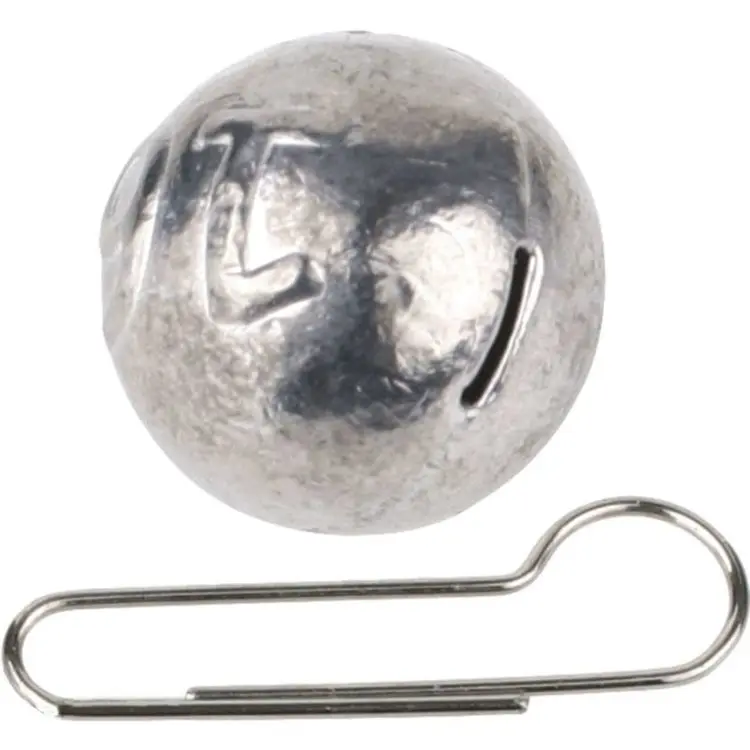
“Cheburashka” is indispensable for mandala fishing. Thanks to the articulated connection with the sinker, this floating lure behaves as naturally as possible. On pauses during the performance of step wiring, it takes a vertical position at the bottom – this increases the number of bites and reduces the number of idle hooks.
Today, many firms produce collapsible “cheburashka”. Such designs allow you to quickly change the bait and do not require the use of additional elements in the form of clockwork rings.
There are also models of “cheburashka” with a spiral in the form of a corkscrew, soldered into a lead load. In this case, the hook is attached to a branch of hard wire. When assembling the structure, the head of the bait is screwed onto a corkscrew, and the “tee” or “double” is stuck approximately in the middle. This installation is most effective when fishing on large vibrotails.
“Bullet”
The bullet-shaped sinker is great for spaced Texas and Caroline rigs. It has a longitudinal through hole and, when assembled, moves freely along the fishing line. Usually such models are made of lead.
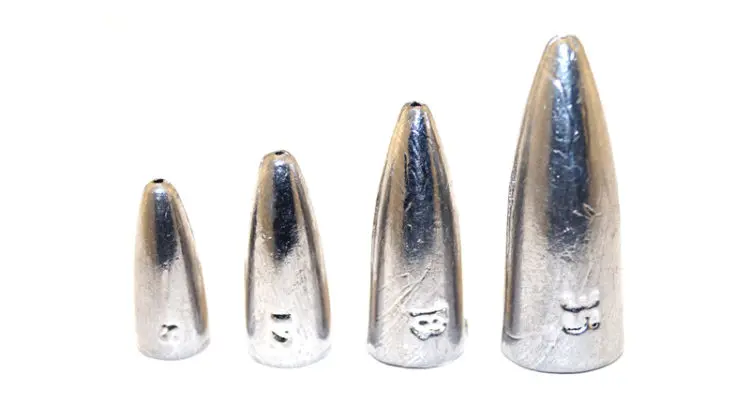
The weight of the “bullets” used in jig fishing rarely exceeds 20 g. Such weights are most effective in still water. Their advantages include:
- good aerodynamic qualities;
- good patency through grass and snags;
- ease of manufacture.
There are also bullet-shaped sinkers soldered onto an offset hook. Such models are excellent for angling pike in shallow, grassy areas.
“Bell”
The bell-type load is made of lead. It has an elongated shape and has an attachment point in the upper, narrowed part.
This type of sinker is commonly used in jig rigs. When passing along the bottom, due to the elongated shape, the “bell” allows the bait to go a little higher than the ground, thereby minimizing the number of hooks.
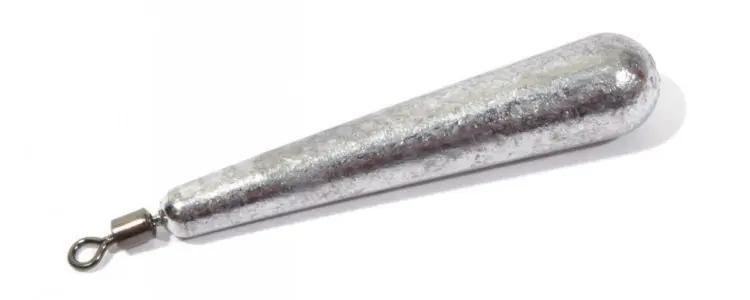
Depending on the type of reservoir and the required casting distance, the weight of the “bell” can vary from 10 to 60 g. This type of jig cargo has good flight qualities.
“Rogue”
The rogue load has the shape of an elongated fish head and is equipped with connecting loops in the front and back. It is designed for fishing in grassy thickets or dense snags. It is produced both in a standard and in a collapsible version.
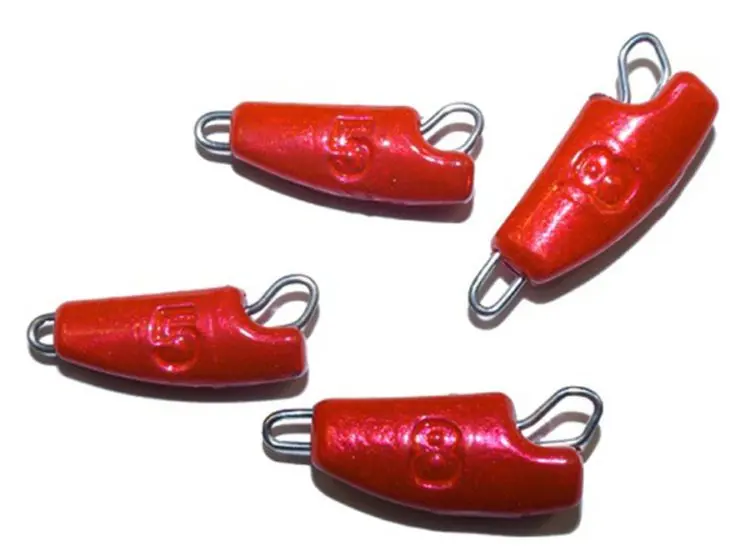
For angling pike in shallow water overgrown with grass, a rogue weighing up to 10 g is suitable. When fishing pike perch in a snag, models weighing 15–30 g are used. This type of sinker works better with narrow-bodied jig baits.
“Not engaging”
Jig heads of the “non-hooking” class are used on a rocky or burrowed bottom. After lowering to the ground, they take up a hook-up position, which minimizes the number of hooks. These models include:
- “horseshoe”;
- “sapojok”;
- “rugby”;
- “vanka-ustanka”.

These models do not have good flight characteristics, so they are best used when fishing from a boat when there is no need to make extra long casts.
“Skiing”
The model called “ski” is designed for pelagic jigging (in the middle layers of the water). Due to its original shape, it passes well through thickets and quickly rises to the surface.
“Ski” does not have good flight characteristics, so it is used for close-range fishing. Effectively works only with narrow-bodied worm-type lures.
Noise
Noise jig heads consist of a weight with a soldered hook, on the forearm of which a small propeller is mounted. During wiring, this element rotates, creating an additional attracting effect.
Such models work well when the predator is active. Such designs can scare away passive fish.
“Horse head”
The jig head called “horse head” has a rather complex design. A metal petal is mounted in its lower part, which actively oscillates when moving, attracting fish well.
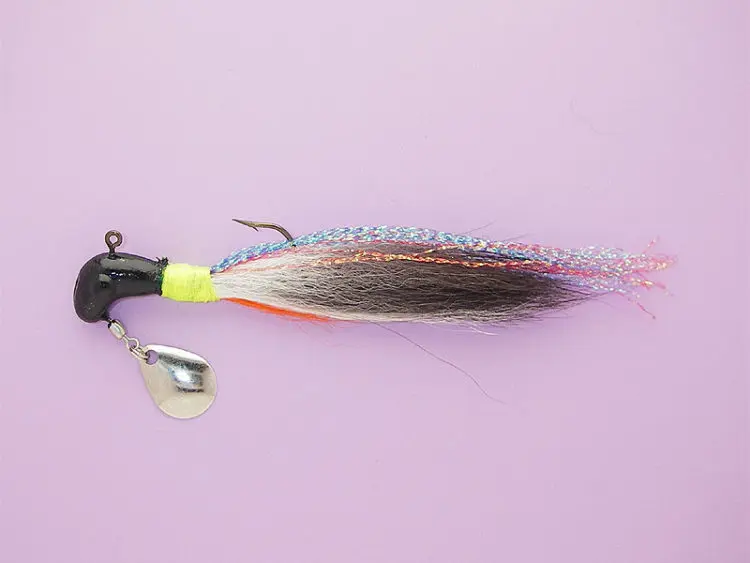
Due to the original shape, this model successfully “jumps” underwater obstacles in the form of stones and snags lying on the bottom, minimizing the loss of lures. It shows itself better when angling pike.
“Pear”
A pear-shaped sinker is more often used in leash jig rigs of the Moscow type. It has the following benefits:
- easy to make with your own hands;
- has excellent aerodynamic qualities;
- passes well through snags and blockages of stones.
Due to its excellent flight characteristics, this type of sinker is often used in coastal fishing, when the bait needs to be cast over an extra long distance.
“Winged”
The “winged” sinker is a metal element mounted on a plastic blade and a wire frame. It is used in cases where it is necessary to ensure the slowest possible fall of the bait in the process of stepped wiring.
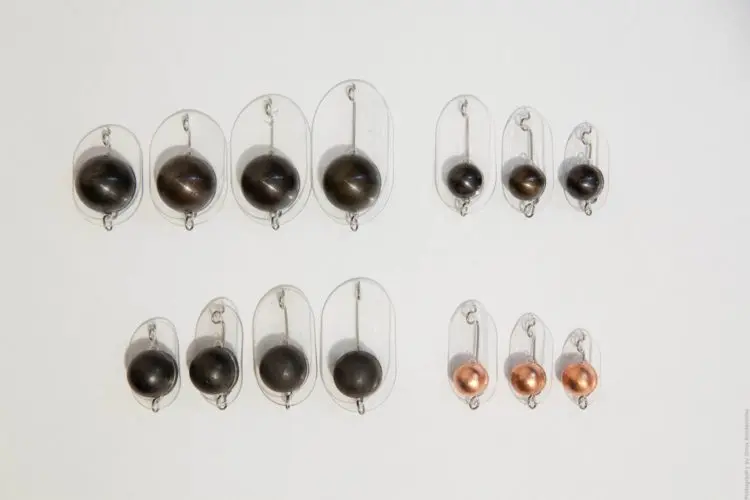
Photo: www.novfishing.ru
Unfortunately, such models are difficult to manufacture on their own, and the price for them can be quite high. This makes fishing very costly.
«Dart»
Dart jig heads are shaped like a wobbler blade. They are used for deep water fishing. With jerky wiring, such models make the bait scour from side to side.
“Dart” is used only with “slug” lures. They are more suitable for angling marine predators who prefer aggressive baiting. In fresh water, such models perform much worse.
Dart weights usually weigh no more than 10 g. They are more often used for catching horse mackerel from the shore.
lead liquor
Lead liquor applied to an offset hook can also be classified as a type of jig sinker. Such models are usually used for pike fishing in shallow areas, when it is necessary to achieve the slowest possible immersion of the bait.
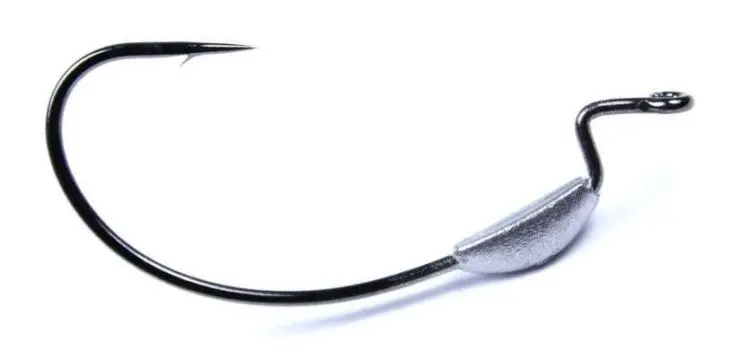
Lead is welded on the lower part of the hook, which helps to stabilize the bait in the fall. A loaded offset is often used in combination with narrow-bodied vibrotails, twisters and slugs.
“Wobble”
The Wobble jig head is shaped like a petal bent up. The fastening ring is located in its front part, which ensures a quick exit of the bait to the surface.
When dropped on a stepped reel, the Wobble sways slightly, giving the lure an extra play. It is used in combination with silicone imitations of the “slug” type. Better suited for fishing small sea predators from the shore.









